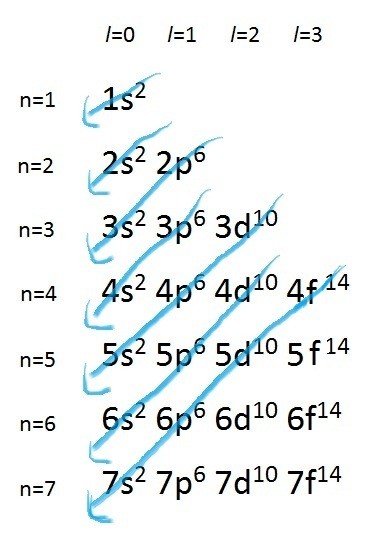Understanding the arrangement of electrons within an atom is fundamental to grasping its chemical behavior. This arrangement, known as the electron configuration, isn’t random. Instead, it’s governed by three key principles that dictate how electrons fill available energy levels and orbitals. These principles are the Aufbau Principle, Hund’s Rule, and the Pauli Exclusion Principle. Knowing What 3 Principles Guide The Electron Configuration Of An Atom is crucial for predicting bonding ability, magnetic properties, and other chemical characteristics.
Electron Configuration: A Primer
The electron configuration describes which orbitals are occupied by electrons in an atom. This description is based on quantum numbers, which define the energy and spatial distribution of each electron. The four quantum numbers are:
- Principal quantum number (n): Indicates the energy level or shell (n = 1, 2, 3, …).
- Azimuthal or angular momentum quantum number (l): Describes the shape of the orbital (l = 0, 1, 2, …, n-1, corresponding to s, p, d, and f orbitals, respectively).
- Magnetic quantum number (ml): Specifies the orientation of the orbital in space (ml = -l, -l+1, …, 0, …, l-1, l).
- Spin quantum number (ms): Represents the intrinsic angular momentum of the electron, which is quantized and called spin. An electron has spin either up (+1/2) or down (-1/2).
The Three Guiding Principles
The electron configuration of an atom is determined by the interplay of these three principles:
1. Aufbau Principle
The Aufbau principle, derived from the German word “Aufbauen” meaning “to build up,” states that electrons first occupy the lowest energy orbitals available before filling higher-energy orbitals. The order of orbital filling is generally:
1s < 2s < 2p < 3s < 3p < 4s < 3d < 4p < 5s < 4d < 5p < 6s < 4f < 5d < 6p < 7s < 5f < 6d < 7p
This order can be visualized using the Madelung’s Rule or the diagonal rule.
Figure 1. Madelung’s Rule provides a visual aid for remembering the order in which electrons fill atomic orbitals.
While the Aufbau principle is a useful guideline, there are exceptions, particularly among transition metals, due to subtle energy differences between orbitals.
2. Hund’s Rule
Hund’s rule states that within a subshell (e.g., the 2p subshell), electrons individually occupy each orbital before any orbital is doubly occupied. Furthermore, the electrons in singly occupied orbitals have the same spin (parallel spins). This arrangement minimizes electron-electron repulsion and leads to a more stable configuration.
Figure 2. Illustration of the correct (a) and incorrect (b) application of Hund’s Rule for Nitrogen’s electron configuration.
For example, nitrogen (N) has three electrons in its 2p subshell. According to Hund’s rule, these electrons will occupy each of the three 2p orbitals (2px, 2py, and 2pz) singly, with parallel spins.
3. Pauli Exclusion Principle
The Pauli Exclusion Principle, formulated by Wolfgang Pauli, states that no two electrons in an atom can have the same set of four quantum numbers. This implies that each orbital can hold a maximum of two electrons, and these two electrons must have opposite spins (spin-paired). If two electrons occupy the same orbital, they have the same n, l, and ml values, but must have different ms values (+1/2 and -1/2).
Electron Configurations of Ions
The principles discussed above also apply to ions (charged atoms).
- Cations (positive ions): Electrons are removed from the outermost shell (highest n value) first. Within a given shell, electrons are removed from the p orbitals before the s orbitals, and then the d orbitals.
- Anions (negative ions): Electrons are added to the lowest energy empty or partially filled orbital, following the Aufbau Principle and Hund’s Rule.
For example, the electron configuration of neutral calcium (Ca) is 1s22s22p63s23p64s2. When calcium forms a Ca2+ ion, it loses two electrons from the 4s orbital, resulting in the electron configuration 1s22s22p63s23p6, which is isoelectronic with argon (Ar).
Significance of Electron Configuration
Understanding electron configurations is crucial for several reasons:
- Predicting Chemical Properties: The number of valence electrons (electrons in the outermost shell) determines an element’s bonding behavior and reactivity.
- Explaining Magnetic Properties: Elements with unpaired electrons are paramagnetic (attracted to a magnetic field), while elements with all paired electrons are diamagnetic (repelled by a magnetic field).
- Understanding Periodic Trends: Electron configurations explain trends in ionization energy, electronegativity, and atomic size across the periodic table.
Conclusion
The electron configuration of an atom, governed by the Aufbau Principle, Hund’s Rule, and the Pauli Exclusion Principle, provides a fundamental understanding of its electronic structure and chemical behavior. By mastering these three principles, one can predict the electron configuration of various atoms and ions and understand the resulting chemical properties.
Practice Problems
- Which principle states that electrons fill the lowest energy orbitals first?
- Explain Hund’s Rule and its importance in determining electron configuration.
- How does the Pauli Exclusion Principle limit the number of electrons in an orbital?
- Write the electron configuration for the following:
- Oxygen (O)
- Iron (Fe)
- Copper (Cu) (note: Copper is an exception to Hund’s rule)
- What is the electron configuration of the chloride ion (Cl-)?
References
- Atkins, P. W., & De Paula, J. (2006). Physical Chemistry for the Life Sciences. New York, NY: W. H. Freeman and Company.
- Petrucci, R. H., Harwood, W. S., & Herring, F. G. (2002). General Chemistry: Principles and Modern Applications. Upper Saddle River, NJ: Prentice-Hall, Inc.
- Shagoury, Richard. Chemistry 1A Lecture Book. 4th Ed. Custom Publishing. 2006. Print

